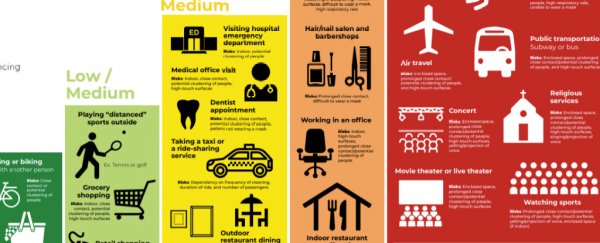When businesses began reopening from the coronavirus shutdown across the US, Arizona-based epidemiologist Saskia Popescu started fielding a whole series of new questions from colleagues, friends, and worriers on the internet.
Everyone, it seemed, had questions.
Can I eat at a restaurant?
Can I play tennis?
Can I golf?
"We were finding just that people really struggled to understand risk dynamics," Popescu, from the University of Arizona and George Mason University, told Insider.
"There was this kind of false dichotomy of either you stay in, or you go out and it's really, really dangerous."
So Popescu got together with two of her colleagues to decide, collectively, which activities they thought were safest, and which might be most hazardous during the pandemic.
"You can still live your life and not feel so trapped by what's going on right now," Popescu said.
Here's the chart that she, along with Dr James Phillips (George Washington University) and Dr Ezekiel Emanuel (University of Pennsylvania), created.
It ranks activities from dark green (safest) to red (very risky).
(You can see a larger version of the graphic here.)
 (Ezekiel J Emanuel, James P Phillips, Saskia Popescu/Covid19reopen.com)
(Ezekiel J Emanuel, James P Phillips, Saskia Popescu/Covid19reopen.com)
"Nothing is zero risk right now," she said. "It's about trying to reduce the risk as much as possible."
Popescu, Phillips, and Emanuel also have a consulting business, where they weigh these kinds of risks for companies and advise them on the safest ways to reopen during the pandemic. But they created this chart knowing not everyone may be as cautious as them.
"I can't assume everybody is doing the right thing and taking the necessary steps in their business, or in that environment," she said. "I'd rather you be cognisant of that."
For example, taking public transportation is listed as a high risk red-coloured activity on this chart, because it's in an enclosed space where you may have prolonged, close contact with others, and there are high-touch surfaces involved (doors, chairs, etc.)
It could be the case that busses and trains in a certain city, or within a certain company, have put in place the proper precautions. Adequate social distancing, masking requirements, and sanitizing measures could bring a bus trip down into a less risky category of activity.
The important thing is to "know what to look for when you're trying to make those decisions," Popescu said.
Good air circulation, minimising time indoors and with crowds, and better hygiene are all key.
"We all collectively agree that going to a concert is a really bad idea," she said.
The risk propositions of some other activities aren't always as clear-cut and will depend on how you approach them.
"Golf, for example, it's going to be low-risk if you're doing it by yourself, or you're a part of a group and you're all socially distanced and you're taking your own golf cart and wearing masks when you're around each other," Popescu said.
"But if you're all together in one golf cart, drinking and not really wearing your mask, that's going to be high risk."
This article was originally published by Business Insider.
More from Business Insider:
